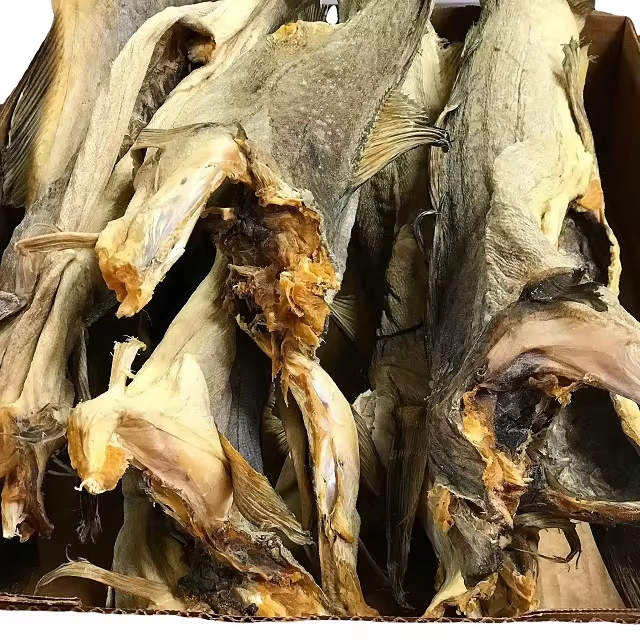Dried stockfish is a preserved fish product that has been air-dried or sun-dried to extend its shelf life and enhance its flavor. It’s commonly used in various cuisines around the world. Here’s a detailed look at dried stockfish:
What is Stockfish?
- Stockfish is typically made from white fish, such as cod, haddock, or ling. The fish is cleaned, salted, and then air-dried or sun-dried for several months. This preservation method intensifies the fish’s flavor and texture.
Characteristics:
- Appearance: Dried stockfish is usually sold in its whole form or as pieces. It appears dry, hard, and often has a pale color. The drying process causes the fish to lose most of its moisture, making it lightweight.
- Texture: The texture of dried stockfish is very firm and brittle. It can be rehydrated before cooking to return it to a more traditional texture, although it will still be denser than fresh fish.
- Flavor: The drying process concentrates the fish’s flavor, giving stockfish a strong, umami-rich taste. It has a distinctive, slightly pungent smell that can be quite intense.
Preparation and Cooking:
- Rehydration: Dried stockfish needs to be soaked before cooking. The soaking process can take from 24 to 48 hours, depending on the size and thickness of the fish. To rehydrate, place the stockfish in a bowl of water and keep it in the refrigerator.
- Cooking:
- Boiling: After soaking, stockfish can be boiled to further soften it and incorporate it into dishes. It is often used in soups, stews, and sauces.
- Grilling or Baking: Once rehydrated, stockfish can be grilled or baked, similar to fresh fish, though it may require longer cooking times due to its dense texture.
- In Recipes: Dried stockfish is commonly used in traditional dishes from various cuisines, such as West African stews, Scandinavian dishes, and Italian recipes. It can be flaked and used as a flavoring ingredient.
- Storage:
- Dry Storage: Keep dried stockfish in a cool, dry place in an airtight container to maintain its quality. It can be stored for several months or even years if kept properly.
- Refrigeration: Once rehydrated, stockfish should be kept in the refrigerator and used within a few days.
Uses in Cuisine:
- West African Cuisine: Dried stockfish is a staple in many West African dishes, such as soups and stews. It adds a distinctive flavor and is used in dishes like Nigerian Egusi soup and Ghanaian light soup.
- Scandinavian Cuisine: In Scandinavian countries, stockfish is traditionally used in dishes like lutefisk and is an important part of culinary heritage.
- Italian Cuisine: In Italy, stockfish is used in various regional recipes, including stews and pasta dishes.
Nutritional Value:
- Protein: Stockfish is high in protein, making it a good source of essential amino acids.
- Minerals: It is also rich in minerals such as iodine, calcium, and magnesium.
- Low in Fat: Dried stockfish is low in fat, making it a lean protein source.
Sustainability:
The sustainability of dried stockfish depends on the fishing practices used to catch the fish. When purchasing stockfish, look for products that come from fisheries with responsible and sustainable practices. Certifications and sourcing information can often indicate how the fish was harvested.
Dried stockfish is a versatile and flavorful ingredient that adds a unique depth to dishes. Whether you’re incorporating it into traditional recipes or exploring new culinary creations, it’s a valuable addition to many kitchens.






